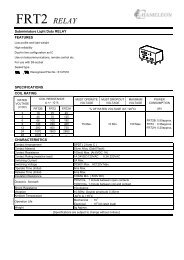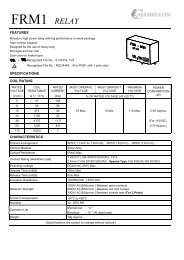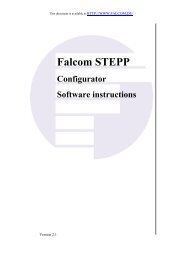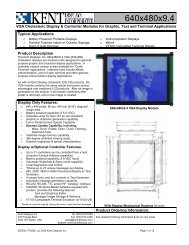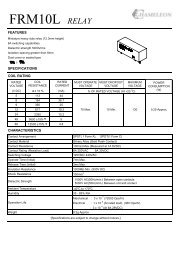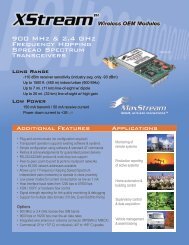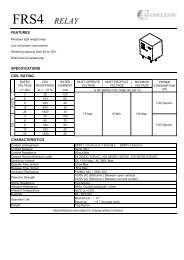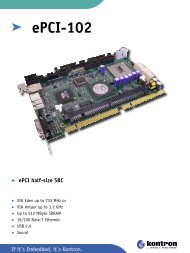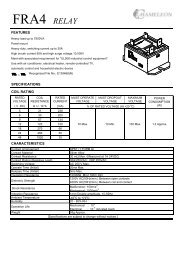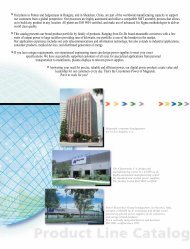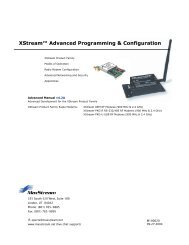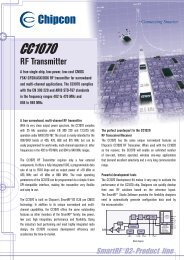STANDARD SERIAL COMMUNICATION INTERFACE and ...
STANDARD SERIAL COMMUNICATION INTERFACE and ...
STANDARD SERIAL COMMUNICATION INTERFACE and ...
Create successful ePaper yourself
Turn your PDF publications into a flip-book with our unique Google optimized e-Paper software.
St<strong>and</strong>ard Serial Interface Protocol Description<br />
8 "7" , ,<br />
<br />
9 "8" , Duration<br />
(Hex)<br />
10 "9" , , , <br />
3 N/A 0 Set/Clear Invert sense of Display<br />
image.<br />
2 N/A 0 Set Unique Pause Duration for<br />
respective message for Auto cycle<br />
operation (in 0.1 second<br />
increments).<br />
4 N/A 0 Start Automatic Image Cycling<br />
using the parameters specified.<br />
*11 ";" N/A 0 N/A 0 Ask Sign for display (Panel) Count.<br />
Host will receive message f/sign<br />
after positive response is received.<br />
12 "M” 1 N/A 0 Turn OFF/ON Sleep Timer (ON<br />
after reset or power-up)<br />
13 "O" N/A 0 N/A 0 Output ChLCD Temperature from<br />
Sign. Host will receive a<br />
Temperature message f/sign after<br />
positive response is received.<br />
14 "P" Duration (Hex) 1 N/A 0 Set Default Pause Duration<br />
between message writes, in 0.1<br />
second increments (25.5 sec.<br />
Duration maximum).<br />
15 "R” N/A 0 N/A 0 Reset Sign (Clears any data<br />
previously entered into the sign<br />
RAM).<br />
16 "S" N/A 0 N/A 0 Stop Automatic Message Cycling<br />
(Overrides any previous "t"<br />
comm<strong>and</strong>)<br />
17 “V” N/A 0 N/A 0 Sign Firmware ID Request. Host<br />
will receive a sign message after<br />
positive response is received.<br />
18 “W” 1 N/A 0 Display Message # X on Sign.<br />
19 "X" , <br />
2 N/A 0 Blank Display or panel #’s<br />
indicated.<br />
20 "Z" N/A 0 N/A 0 Turns OFF the Addressed<br />
Controller(s)<br />
NOTES: * - indicates comm<strong>and</strong> is only available in INFOSign III based products.<br />
Table 5.2.1: INFOSIGN Host to Display Application Level Comm<strong>and</strong>s (Continued)<br />
Where:<br />
1. = The message (or "Page" when using the INFOSoft) number, 1 thru the maximum<br />
# of messages for the sign (in hex) for the respective message packet. Refer to section 5.2.3<br />
for determining the maximum number of the messages which can be stored within a<br />
respective INFOSign master module.<br />
2. = bit mapped data for the respective INFOSIGN panel 30x240 "l<strong>and</strong>scape<br />
mode" image, starting from 1st row (top) left to 1st row (top) right, 2nd row left to 2nd row<br />
right, ...30th row left to 30th row right. In other words, bit 0 must be in bit 7 position, bit 1<br />
must be in bit 6 position, etc…<br />
3. ETX = End of Transmission Comm<strong>and</strong> byte (03 Hex). Indicates end of application layer message<br />
packet.<br />
4. = Indicates the number of image writes the display module is to generate<br />
before stopping. If the user provides a (Hex) into this respective location, the display<br />
module will assume the message cycling is to resume indefinitely, overriding the "sleepmode"<br />
feature of the display module (Not recommended for long term battery operation).<br />
5. = Off (non-inverted), <strong>and</strong> On (inverted)<br />
6. ON Update Method – Byte to indicate how the controller is to present the respective partial image<br />
or message. The following codes apply (Only available with INFOSign III based product):<br />
St<strong>and</strong>ard Serial Communication Interface Description, © 1998-2002 Kent Displays Inc., doc. # 25016 Revision T, Page 12 of 52



